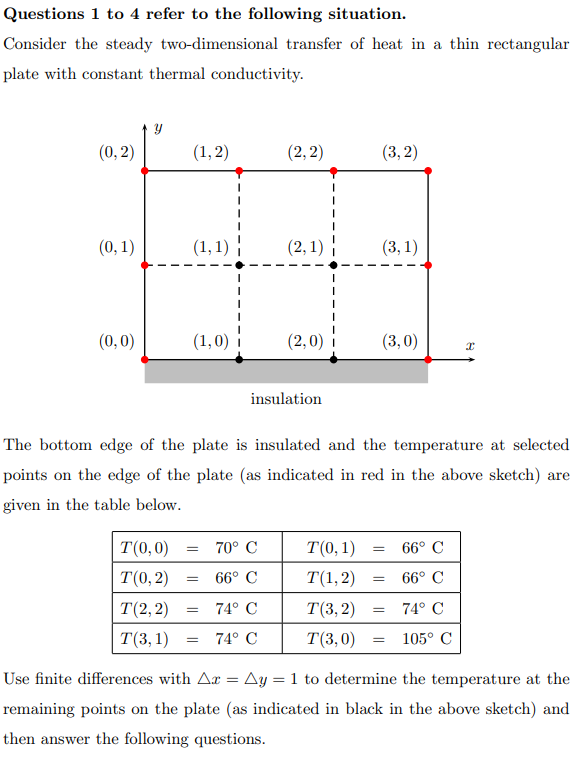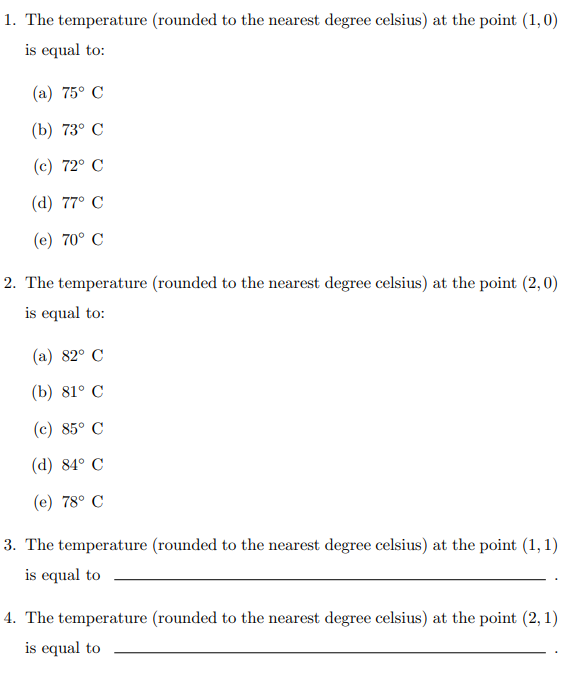Use finite differences with Ar = Ay = 1 to determine the temperature at the remaining points on the plate (as indicated in black in the above sketch) and then answer the following questions.
Use finite differences with Ar = Ay = 1 to determine the temperature at the remaining points on the plate (as indicated in black in the above sketch) and then answer the following questions.
Refrigeration and Air Conditioning Technology (MindTap Course List)
8th Edition
ISBN:9781305578296
Author:John Tomczyk, Eugene Silberstein, Bill Whitman, Bill Johnson
Publisher:John Tomczyk, Eugene Silberstein, Bill Whitman, Bill Johnson
Chapter11: Calibrating Instruments
Section: Chapter Questions
Problem 4RQ: Temperature-measuring instruments may be designed to measure the temperature of vapors, ________,...
Related questions
Question
100%
Plz solve these questions need within 1 hour

Transcribed Image Text:Questions 1 to 4 refer to the following situation.
Consider the steady two-dimensional transfer of heat in a thin rectangular
plate with constant thermal conductivity.
(0, 2)
(0, 1)
(0,0)
Y
(1,2)
T(0,0)
T(0,2)
(1,1)
(1,0)
=
=
T(2, 2) =
T(3,1) =
(2, 2)
(2,1)¦
70° C
66° C
74° C
74° C
(2,0)
insulation
The bottom edge of the plate is insulated and the temperature at selected.
points on the edge of the plate (as indicated in red in the above sketch) are
given in the table below.
(3,2)
(3,1)
(3,0)
T(0,1)
T(1,2) =
T(3,2) =
T(3,0) =
=
x
66° C
66° C
74° C
105° C
Use finite differences with Ar = Ay = 1 to determine the temperature at the
remaining points on the plate (as indicated in black in the above sketch) and
then answer the following questions.

Transcribed Image Text:1. The
temperature (rounded to the nearest degree celsius) at the point (1,0)
is equal to:
(a) 75° C
(b) 73° C
(c) 72° C
(d) 77° C
(e) 70° C
2. The temperature (rounded to the nearest degree celsius) at the point (2,0)
is equal to:
(a) 82° C
(b) 81° C
(c) 85° C
(d) 84° C
(e) 78° C
3. The temperature (rounded to the nearest degree celsius) at the point (1, 1)
is equal to
4. The temperature (rounded to the nearest degree celsius) at the point (2, 1)
is equal to
Expert Solution
This question has been solved!
Explore an expertly crafted, step-by-step solution for a thorough understanding of key concepts.
Step by step
Solved in 5 steps

Knowledge Booster
Learn more about
Need a deep-dive on the concept behind this application? Look no further. Learn more about this topic, mechanical-engineering and related others by exploring similar questions and additional content below.Recommended textbooks for you

Refrigeration and Air Conditioning Technology (Mi…
Mechanical Engineering
ISBN:
9781305578296
Author:
John Tomczyk, Eugene Silberstein, Bill Whitman, Bill Johnson
Publisher:
Cengage Learning

Refrigeration and Air Conditioning Technology (Mi…
Mechanical Engineering
ISBN:
9781305578296
Author:
John Tomczyk, Eugene Silberstein, Bill Whitman, Bill Johnson
Publisher:
Cengage Learning